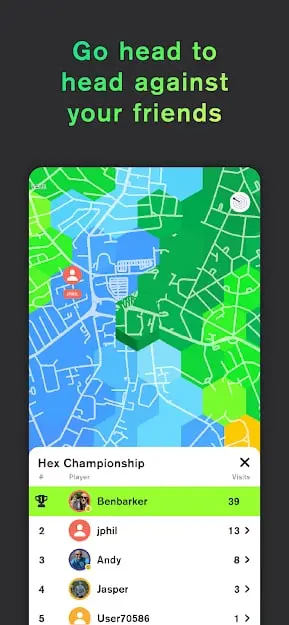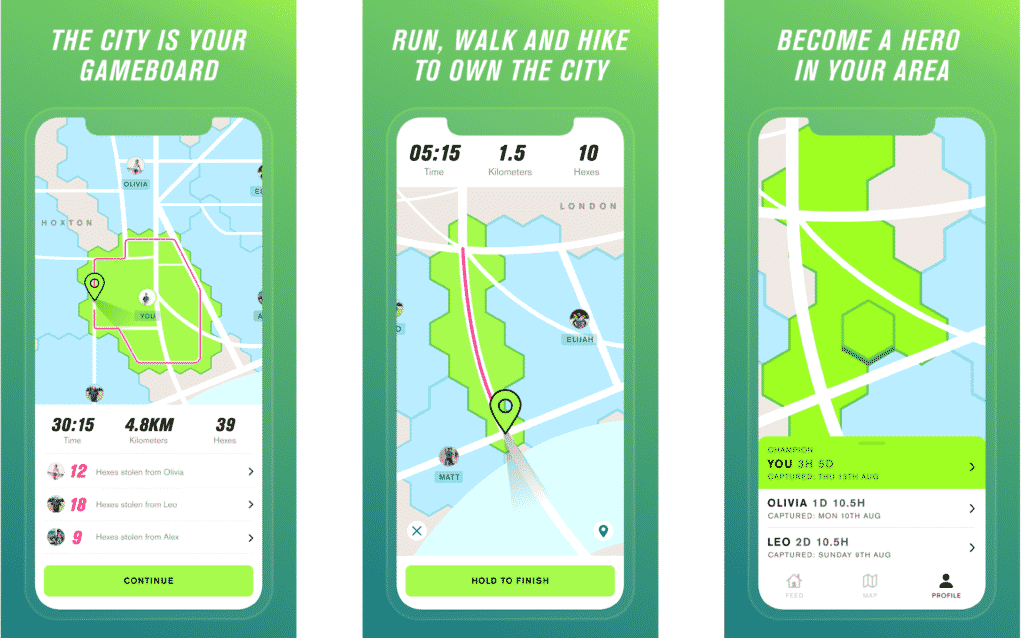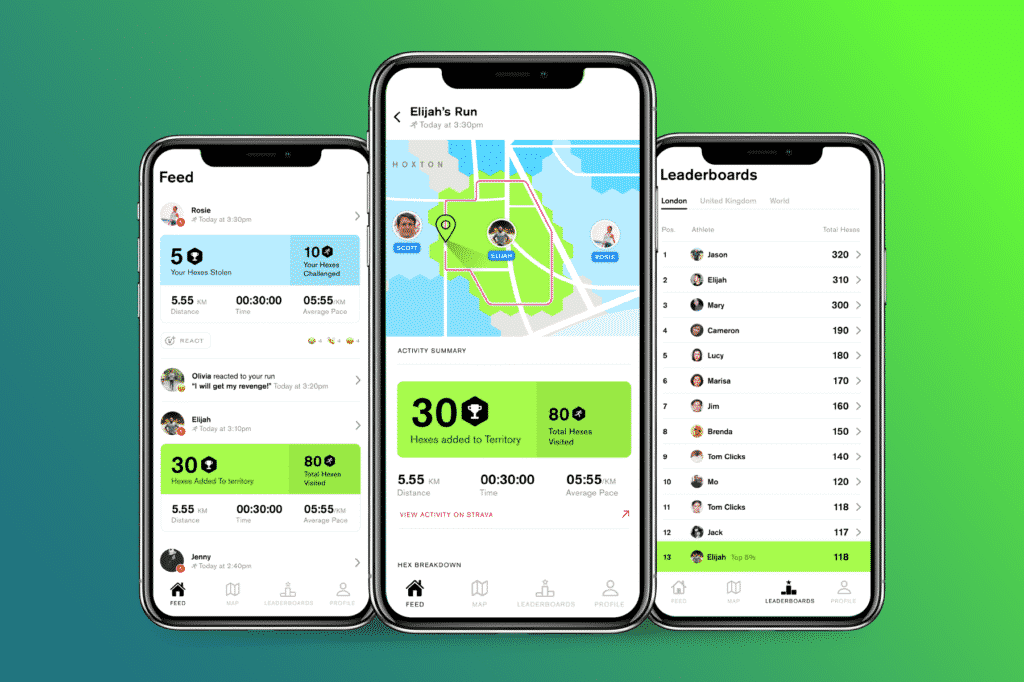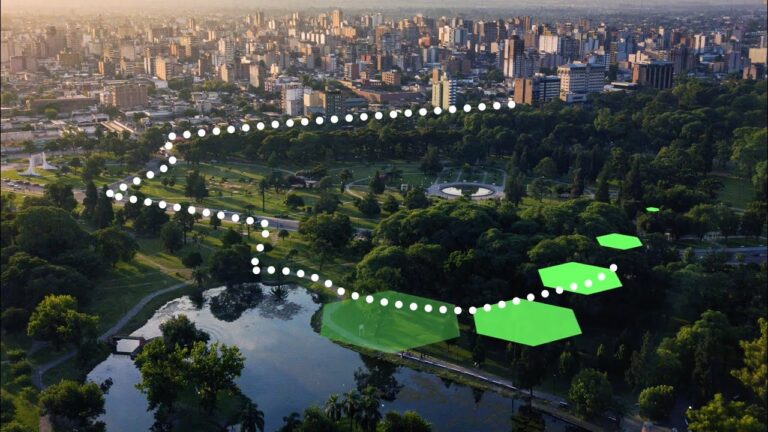We enjoy a little friendly competition and tend to attend events regularly. And besides, having an incentive to push oneself is usually beneficial. However, it’s also nice to have a rivalry that isn’t dependent on speed — something that offers a more even playing field — and that’s where Stride running app enters in. And Stride is a game about capturing territory. So let’s see how you do so?
What will you see here?
Short Review: Stride App Game
On iOS and Android, the Stride app is available (for basic features), and the game mechanics are as follows: It divides the world into hexagonal tiles so that you can claim a tile anywhere you run (or stroll, or ride in your wheelchair). You’ll also receive the tiles at the loop’s center if your path brings you into a closed loop. Whoever has visited each tile the most times owns it.
If you enjoy competing on Strava for KOM (king of the mountain) bragging rights, you might enjoy Stride’s flavor of competition. Stride game tiles are awarded depending on the number of visits, not speed—you could be the slowest runner in the world, but if you run the same park route every day, it could be yours.
How do you play Stride?
Stride is a game about capturing territory. When you open the app and enable your position, the map around you is divided into hexagonal tiles, representing around 60m in real life. These are known as hexes, and the game’s goal would be to collect as many as possible. You become the owner of a hex if you complete it — which you can do while running or strolling — until someone takes it away. Regardless of pace, the owner is the one who has completed the hex the most times. While many of the top running applications emphasize speed and duration. You may still conquer the territory in Stride if you visit it frequently enough. If your path is a loop, you must also claim all squares in the loop’s middle.
Stride app: Free vs. Paid

The stride app can be played without a membership right away, but the comprehensive scoreboards are only available in the paid edition. You can see the scoreboards you might wish to target. Other subscription features include “premium reactions,” which allow you to congratulate friends and taunt opponents. You may also add a badge to your profile and customize the map style.
The Stride app is currently developing territory and may not have many users in some locations. Whether these solutions are worthwhile may depend on your local location and the number of players in your immediate vicinity. You do have the option of a month-long free trial. After that, it’ll cost you £34.99/$44.99 every year. This would be a reasonable amount of time to play around with the app and see whether you’re hooked.
Interface and features

Before you go, glance at the Stride app map to see the various hexes — or groups of them — who the champions are almost by their user name & profile photo, which you may click for additional information. A few words dominate the hexes in the neighborhood, implying that the software has a long way to go before it attracts enough users to justify the subscription edition, at least in this area. But it’s part of the game’s attraction how you can see all of this before you start, giving you time to choose your strategy. As a result, it serves as both an exercise and a strategic challenge.
It is simple to get started. Hit start and go. You can genuinely target specific hexes if you examine the map while moving. If anything, it encourages you to take it easy and have fun dashing down side alleyways in search of extra tiles that aren’t too far off the beaten path but take a little detour. Of course, some of these hexagrams may already be firmly established territory for your local rivals. Therefore one visit won’t suffice. But it’s simple enough to tap on a hex and check who the current owner is and how many visits they’ve made.
Green represents your area, blue and purple represent your competitors, and yellow indicates that you and another user have tied for ownership of that hex with the same amount of visits. Grey suggests that no one has visited that hex yet. However, I believe that none of this is entirely evident at first and that a good key and notes on color-coding would be helpful.
Stride Game Design

 The stride running app is designed for activities of the foot, as the name implies. So you won’t be able to sweep up on your bike or even in the car. It does, however, provide a wheelchair user option, which is a beautiful, inclusive feature. There’s always someone to play with or plot against because the map is accessible to local runners. There’s no private run option because the game wouldn’t work that way. The more people use it locally, the more competitive the gameplay becomes. But grabbing unclaimed tiles is still a lot of fun.
It would be nice for those concerned about privacy if there were a way to add a geoblocking option that allowed you to specify a perimeter around your home (like you can on Strava, for example). You might even use and assume a name and an anonymous profile image if this option mark during the sign-up process. However, this brings up one of the game’s flaws: if you fight with neighborhood walkers and runners, they can see your paths.
The stride running app connects to both your Garmin and Apple Health accounts. However, I found the importation of actions from such connected applications to be somewhat glitchy and unreliable, and the game plays great with the app on your phone.
Smartwatch apps
Stride has an Apple Watch application, but I’ll admit that I’ve never been able to get it to work. It doesn’t help that “Stride” is a common nickname for exercise programs and applications. So searching for “stride” and “apple watch” isn’t that helpful. Again, it appears that it is an early version with errors and quirks that need to work out before utilizing it—considering the Apple Watch’s small screen. It’s difficult to see how staring at tiny hexes on a map would be very useful. This is unquestionably a “phone’s greatest” app.
Stride app: Groups and social

The stride running app allows you to play as a loose cannon or as part of a gang or coalition. You’ll need to have an alliance code for this, but it’s unclear how or where you can get one unless you already have a true friend playing it. You can, however, make your own because recruit your pals to play. It doesn’t have to be competitive with your friends. If there are many people in your area, joining up would be fantastic since you could organize to conquer territory together in such a multi-pronged assault on your opponent’s hexes.
Conclusion
The stride running app concept appeals to me, as does how it emphasizes consistency and strategy above speed. It made me reconsider my route choices – simple now, and backs are indeed a waste of Stride when looping is more profitable. I also enjoy the fact the speed has no bearing on how excellent you are at the game.
However, the game appears to be in its early stages. It’s quite promising, but it’s not nearly worth the hefty subscription charge. It also requires more users (at least in my area) and more development and updates.
While it’s unlike other popular running applications, some aspects of the games work better with others. For example, Strava’s Local Legend rewards you for visiting a specific segment or length of road the most often, irrespective of pace.
Read more:
- How to add, cache, search for, and delete songs from Apple’s new Music app?
- Find and Organize your Google Gmail Contacts!
- Find locations and get directions on iPhone with Maps App!
- Name and save locations with Maps on iPhone and iPad!
- Best computer in 2022: computers for every need and budget














